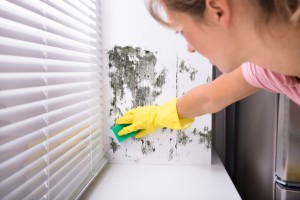
In the first part of this blog (Stop the mould – Part 1: Understanding internal moisture), I explained the terms humidity and relative humidity (RH), that is, the amount and percentage of atmospheric moisture vapour.
Mould on surfaces grows from the mould spores that are all around us in the air. While we cannot eliminate them, they are harmless as long as we do not provide the three conditions that enable them to grow, that is, suitable temperature, a food source and moisture. The indoor environment caters to the first two conditions: we heat indoor spaces to provide the conditions in which mould likes to grow, but moulds can also grow in a wide range of temperatures so unheated indoor spaces can still sustain mould growth; and food sources for mould include many of the building and furnishing materials in our homes.
But for mould to grow, moisture is required, readily provided when the RH is above 70% although, as with temperature, some moulds can survive at far lower moisture levels.
New Zealand, being surrounded by ocean, generally has a relatively high humidity but our indoor spaces are typically have higher levels than outdoors.
Moisture in homes is generated by the occupants and comes from a wide variety of sources including cooking, bathing, clothes washing, and even breathing. While we cannot stop any of these activities, we can control the indoor moisture levels.
In the summer, we provide ventilation by opening windows and doors to admit fresh air and remove moist air. But in the winter, we tend to keep windows and doors closed, limiting both the amount of incoming fresh air and the removal of moist air. Without adequate ventilation to remove moisture, the indoor humidity levels will continue to increase and enable mould to grow.
What can we do to control internal moisture?
There are a number of actions we can take to eliminate, remove and manage moisture:
1. Eliminate unnecessary moisture sources:
- Clothes should not be dried indoors unless in a very well ventilated space (it is estimated that up to 5 litres of moisture is contained in one load of washing!)
- If you have a leak, call your landlord or property manager immediately.
2. Remove the moisture at source:
- Under the Healthy Homes Standards (HHS), all rental properties must have mechanical ventilation in kitchens and bathrooms that discharges to outside. The rangehood in the kitchen should be used during cooking and the bathroom fan during showering or bathing.
3. Manage moisture:
- Open windows daily – BRANZ has determined that opening windows for even 10-15 minutes per day will provide enough ventilation to remove moisture and prevent mould growth.
- If security is an issue with open windows, ask your landlord/property manager to have security stays fixed to windows to allow them to be left open without compromising security.
- If possible, keep a window open at night (it only needs to be a trickle flow of air).
- Where possible, leave doors open to allow air circulation throughout the house.
